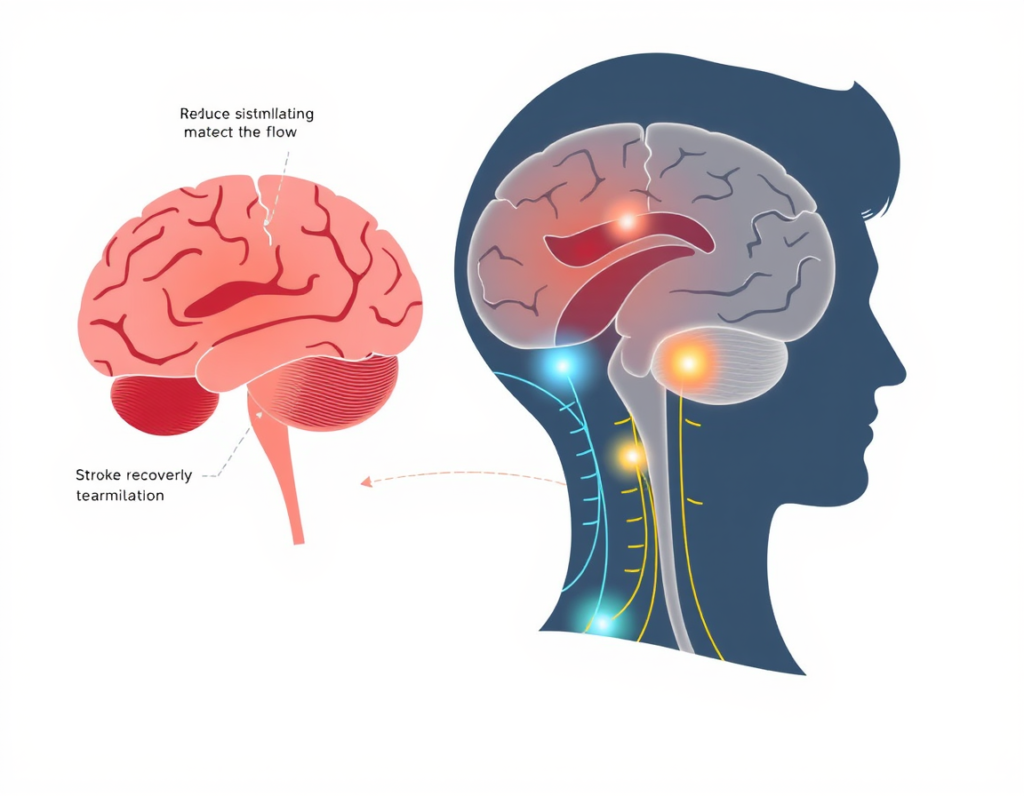Vagus nerve stimulation: a promising therapy for ischemic stroke recovery.
Ischemic stroke is one of the primary causes of disability. A majority of this disability arises from the interruption in blood flow, which leaves the brain cells without oxygen. Even after some progress in stroke care, recovery becomes really tough for people with moderate to severe deficits. People suffering from such intensities are unable to fully recover. Yet there are new therapeutic treatments, and one of the most encouraging is Vagus Nerve Stimulation (VNS). Initially being used to treat neurological and psychiatric conditions such as epilepsy and depression, VNS has been opened up for a potential stroke recovery option for patients after suffering a stroke. This blog will explain how VNS works, how it aids ischemic stroke recovery, and where current research stands.

What is Vagus Nerve Stimulation?
Vagus Nerve Stimulation involves sending electrical impulses to the vagus nerve. The vagus nerve is an important nerve that controls heart rate, digestion, and brain function. Through modulation of brain activity, VNS affects many physiological processes. Neuroinflammation is reduced by VNS, neuroplasticity is enhanced, and post-stroke recovery improved. VNS increases cerebral blood flow, as this is an important aspect of brain healing.
There are two forms of VNS:
- Invasive VNS (iVNS): This procedure involves surgical implantation of a device that is inserted into the skin and sends electrical impulses to the vagus nerve.
- Non-invasive VNS (nVNS): It is a version of electrical impulses applied through the skin over the vagus nerve, generally around the neck area, with no surgical procedure involved.
Although iVNS has a more established history regarding some forms of neurological disorders, nVNS has recently drawn attention as a potentially less invasive approach to treating ischemic stroke.
How Does VNS Help with Recovery from Ischemic Stroke?
Ischemic stroke results in the death of brain cells because of blockage of blood flow. The deprivation of oxygen to the brain results in cell death, causing motor impairments, learning disabilities, and speech impairments. Vagus nerve stimulation addresses several significant factors critical for stroke recovery:
1. Decrease in Infarct Volume:
Preclinical studies with animal models have demonstrated that VNS reduces the size of brain infarcts, areas of dead tissue due to lost blood flow. Less area of the infarct means less brain damage, which is important for general improvement in overall stroke outcomes.
2. Neuroprotection:
VNS can also protect the brain by offering anti-reperfusion injury effects. These are mediated by damage caused when blood flow returns to the brain following an ischemic attack. Minimizing reperfusion injury helps in further aiding brain recovery and prevent it from further damaging.
3. Anti-inflammatory Actions:
Inflammation is a secondary response to injury to the brain but it may exacerbate damage. VNS aids in regulating the immune system, hence decreasing neuroinflammation. When controlling inflammation, VNS allows the brain a chance to heal and recover.
4. Increased Cerebral Blood Flow:
Increasing blood supply to the brain is an essential aspect of stroke rehabilitation. VNS facilitates enhanced flow, therefore, allowing the cells in the brain to gain much-needed oxygen and nutrients for repair. Increased flow promotes function in the brain and enhances recovery.
5. Neuroplasticity Inducement:
An exciting thing about VNS is that it encourages neuroplasticity. Neuroplasticity is the ability of the brain to reorganize itself and adjust by forming new neural connections. This is vital to recovery, especially in patients who experience long-term disabilities as a result of a stroke. The VNS facilitates such brain “rewiring,” which might result in better functional outcomes.
Invasive vs. Non-Invasive VNS
**Invasive VNS (iVNS):
iVNS is FDA-approved for the treatment of conditions such as epilepsy and depression, besides its efficacy in conditions with moderate to severe stroke deficits. Its invasive nature makes it less feasible; it cannot be used for acute stroke due to surgery requirements and risks of infection or complications from the implantation process.
Non-Invasive VNS (nVNS):
A promising alternative for recovery after an ischemic stroke is nVNS. Such stimulation of the vagus nerve is delivered through the skin and avoids surgery. It can typically be used earlier in the recovery process and is generally better tolerated by patients who cannot undergo an invasive procedure. Recent clinical and preclinical studies indicate that, comparable with iVNS, nVNS may offer potential benefits after stroke. More study is necessary to fully understand its potential.
Current Studies and Future Avenues
There is a lot of hope with VNS as an ischemic stroke treatment. Animal studies show that VNS reduces stroke damage while enhancing recovery outcomes. However, how VNS exerts its effects remains largely unknown. The researchers are now focused on understanding the mechanisms through which VNS modulates activity in the brain, inflammation, and neuroplasticity to support recovery from stroke.
While iVNS works well for some stroke patients, the application of this therapy is restricted to the moderate to severe deficit patients. It should not be applied in the acute phase of the stroke. nVNS is a method that is relatively less invasive. Positive results are seen from ongoing clinical trials. Researchers believe that nVNS increases neuroprotection, reduces inflammation, and activates brain repair mechanisms.
Further large RCTs by the researchers will help develop the VNS further for ischemic stroke to optimize nVNS protocols in terms of duration, intensity, timing, and long-term effects. Furthermore, nVNS may be used as an adjuvant to other forms of rehabilitation like PT or cognitive training to enhance recovery outcomes.
Further Info Visit Here
Conclusion: A New Hope for Stroke Recovery
VNS both invasive and non-invasive is of great potential as a therapy for the recovery process of ischemic stroke. It might help in reducing the size of the infarct, stimulate neuroplasticity, enhance blood flow, and decrease inflammation-all measures necessary to restore function and quality of life among stroke patients.
Non-invasive VNS is a minimally invasive alternative with much greater promise for broader applicability. It is especially useful when combined with rehabilitation therapies, such as physical or cognitive therapy. More study is certainly needed but VNS may become a common treatment for stroke recovery in the near future.
The future of ischemic stroke treatment lies in the integration of advanced technologies and rehabilitation strategies. VNS represents one of the most exciting developments in this field. As we uncover the mechanisms behind its success, VNS could turn out to be a cornerstone of stroke therapy with a better recovery prospect for patients and a brighter future for them.
Discover more from fuel for life
Subscribe to get the latest posts sent to your email.




